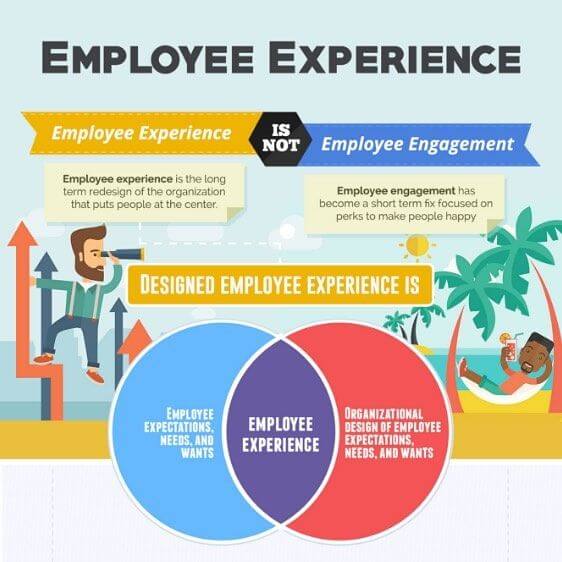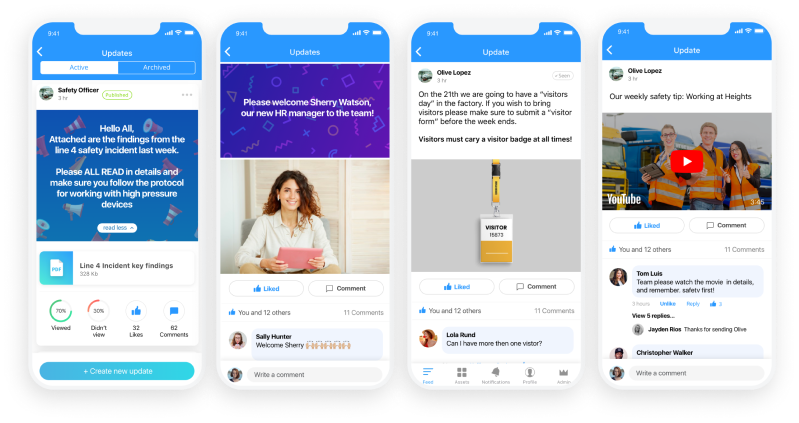Let me guess. Improving employee engagement, motivation, productivity, retention, and employer brand commitment is always at the forefront of your mind. (Yes, that’s a rhetorical question.)
But how do you improve all of the above without breaking the bank or wasting time? Well, you need to shift your focus to employee experience.
This may seem like just another workplace trend but considering the growing need for employee experience managers and the changing of HR policies, I would have to disagree.
What is employee experience? Employee experience is the accumulation of everything an employee goes through while at the company, from the first interview to the first interaction with team members to their very last day at the company. In fact, a recent Deloitte study discovered that 79% of business and HR professionals believe that employee experience is a super important trend.
Gallup further defines employee experience as, “The employee experience is the journey an employee takes with your organization. It includes all the interactions an employee has with your organization before, during and after their tenure.”
Additionally, more reports and studies were done and found that more than 250 global organizations found that companies with amazing employee experience experienced four times larger profits, twice as much on average revenues, and even 40% lower turnover than companies that didn’t. If that doesn’t sum up why investing in employee experience is worth it then we don’t know what will!
However, don’t confuse employee experience with the following listed below. The infographic does a great job of visually explaining the difference and we further drill down into the differences between HR, perks, branding, and employee engagement.
📚 You may be interested in reading our list of the best employee experience platforms of 2025.

- HR: Yes, HR does interact with experience daily, from recruitment to onboarding to performance reviews and so on. However, employee experience deals with so much more than what HR handles – for instance, interactions with IT, company communication, and more.
- Perks: It’s not just about company outings or free lunch, employee experience goes beyond employee incentives and perks. Employee experience is designed to align with your company culture. It is embedded in what your company stands for and helps to deliver.
- Branding: Sure, your company’s reputation can help bring in customers and can improve your recruiting efforts. But employee experience goes beyond that and is focused on the day-to-day experience your company provides to your employees.
- Employee Engagement: We all know how important employee engagement is but if you only focus on the results of employee engagement surveys, you’re missing the point. You need to design and manage employee experience consistently in order to create better engagement.
Although employee experience and employee engagement are inextricably linked, it is becoming abundantly clear that companies focused on engagement alone haven’t been doing enough to understand the factors motivating it, employee experience chief among them.
Once you can separate employee experience from the rest of the noise like company perks, then you can easily improve engagement, motivation, productivity, retention, and commitment.
Let’s dive into how you can curate employee experience at your company with the following tips below.
Connect Employees With Company Values
Employees no longer just want a satisfying paycheck, they want the ultimate employee experience and to be a part of something important. They want their work to matter, to be filled with purpose, and to know they are valued. Your company values aren’t just words in your employee handbook, they are what drive employees to deliver the company goals. When employees are connected to the company’s values, they feel a sense of unity and are committed to working harder and for longer.
In fact, one-third of employees strongly agree with the statement “the mission and purpose of my organization makes me feel my job is important”.
If that’s not enough, a BetterUp Labs survey discovered 9 out of 10 American workers would take a pay cut if they are working a meaningful position. In turn, you see lower turnover rates as employees will work longer and won’t take too much paid time off. Nurture their personal growth, get rid of toxic behaviors, and have a strong social network.
The connection between strong employee experience and company values that resonate with everyone on your payroll can’t be underestimated.
Create A Smooth Onboarding Process
From the very first day, employees need to feel like they really matter. So when they’re exposed to the company culture, his/her job role, and co-workers, they feel utterly connected to their day-to-day responsibilities. When an employee goes home after their first day, you want them to feel like they just had the best first day ever. They should feel energized to keep coming back because they know they matter to the company and what they do matters.
A new hire can be slightly overwhelmed when joining a new company so it’s important to ask them the right onboarding questions as a way to check-in. Additionally, it provides you with key information about the new employee experience so you can use it as a basis to improve the process going forward.
Use Communication Technolgy Solutions
We can’t state the importance of keeping up with advancements in technology when relevant for your business and your employees. Employee experience and employee communication are strongly connected. As such, long gone are the days of text messages, phone calls, emails, WhatsApp groups, and bulletin boards for internal communication.
When you have the right tools on hand, delivering and catering employee experience that is relevant company-wide leads to far better motivation and engagement for starters.
Many managers rely on Connecteam as their primary internal communication app because they can:
- Easily reach all employees in real-time and on the go
- Create and share personalized, targeted content to drive employee engagement
- Support two-way communication with one-on-one chat, surveys, live polls, and a suggestion box
- Keep important documents, files, messages, and conversations under one roof
- Enhance experiences with GIFs, voice notes, memes, or images right in the app
- Maintain work-life separation by communicating exclusively and securely on the app
- Create engagement by sharing birthday wishes, anniversaries, celebrating new hires, giving out shouts to the employee of the month, and much more

Enhance Employee Experience With The Leading Communication App
Gain Feedback Regularly
On a regular basis, you should be gaining feedback from your employees on every possible matter. Whether weekly through an employee satisfaction survey or after onboarding, a meeting, a company outing, and more.
Ask employees if they have ideas or thoughts on how to increase sales, better customer satisfaction, improve performance, and more. Senior managers aren’t the only ones with great ideas! By including all employees and having a platform where they can be heard, they will feel like management genuinely cares about what they have to say and they will feel satisfied in their position.
Remember that your employees are the ones with real boots on the ground so they can shed the best light on what your customers want, need, and aren’t satisfied with.
Be Clear With Your Expectations
If employees don’t know what you want then they won’t be able to deliver and won’t meet your expectations. Be sure to follow these guidelines:
- Know what you want: if you can’t even explain the requirements to yourself then you won’t be able to effectively communicate them to your employees.
- Have a face-to-face: Talk with your employees in person to discuss expectations, whether it’s on a project or overall performance. And be sure to ask your employees their input on what expectations they have.
- Write it down: After the face-to-face meeting, follow up with written confirmation of the key takeaways and make sure the employee agrees.
- Follow-through: Do what you agreed on and meet your employee’s expectations. The last thing you want is to make promises you can’t keep.
Keep Employees Motivated
While employee incentives, like bring your pet to work or working from home or casual Fridays, are amazing to have at your company, there’s more you can be doing.
- Create a community: Create comradeship amongst employees with a company outing or team-building games.
- Create open-door communication: Gain feedback, be transparent, and communicate – this will help with productivity and motivation. If you aren’t sure what your employees need to be more productive or motivated, ask them!
- Create employee purpose: Give your employees more control over their work, so let them set their goals or KPIs and when deadlines are to deliver. Make a plan together and be sure to track progress. Reinforce that their work is valued and benefits the company.
- Say thank you: Employee recognition can go a long way. Saying thank you is just one way to recognize a job well done.
With a thorough and planned out strategy to deliver employee experience on a regular basis, you can easily lead to greater engagement, motivation, productivity, retention, and loyalty.
Create Growth & Opportunities
Today’s workers want more career growth and the training to get there. Just keeping their head down isn’t good enough. And a simple bump in pay doesn’t automatically lead to better engagement or work experiences.
Ensure that your employees know how they excel in the company and in their current job roles.
The numbers don’t lie either, a study by Quantum Workplace found that employees consider professional growth opportunity as one of their highest engagement drivers. And in retrospect, they stated that a lack of growth in advancement was their second-highest reason for leaving the company.
So, send them to seminars (even virtual ones), hold in-house training sessions with leaders in their field, assign them a mentor for better collaboration as well, bring in speakers, and more.
The Bottom Line On Employee Experience
At the end of the day, workplace trends are ever-evolving. Stay up to date on what is trending but don’t implement anything until you’ve done the right research. Plus, you must ensure that these new protocols or initiatives enhance the company culture, otherwise, you’ll hamper employee experience before it even has legs.
Create Employee Experience With Connecteam
Connecteam is your tool to manage employee engagement, experience, development, and relationship. In a click, you can streamline communication, build a working employee experience, give your employees a platform to be heard, boost engagement, strengthen the company culture, align employees with company policies, and more.




